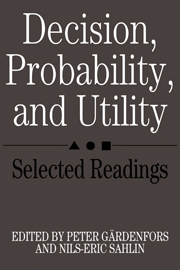Book contents
- Frontmatter
- Contents
- List of contributors
- Preface
- 1 Introduction: Bayesian decision theory – foundations and problems
- Part I Foundations of Bayesian decision theory
- Part II Conceptualization of probability and utility
- Part III Questionable rules of rationality
- 9 Allais' paradox
- 10 Sure-thing doubts
- 11 Prospect theory: An analysis of decision under risk
- 12 Generalized expected utility analysis and the nature of observed violations of the independence axiom
- Part IV Unreliable probabilities
- Part V Causal decision theory
- References
- Name index
- Subject index
11 - Prospect theory: An analysis of decision under risk
Published online by Cambridge University Press: 05 June 2012
- Frontmatter
- Contents
- List of contributors
- Preface
- 1 Introduction: Bayesian decision theory – foundations and problems
- Part I Foundations of Bayesian decision theory
- Part II Conceptualization of probability and utility
- Part III Questionable rules of rationality
- 9 Allais' paradox
- 10 Sure-thing doubts
- 11 Prospect theory: An analysis of decision under risk
- 12 Generalized expected utility analysis and the nature of observed violations of the independence axiom
- Part IV Unreliable probabilities
- Part V Causal decision theory
- References
- Name index
- Subject index
Summary
Introduction
Expected utility theory has dominated the analysis of decision making under risk. It has been generally accepted as a normative model of rational choice (Keeney and Raiffa, 1976), and widely applied as a descriptive model of economic behavior (e.g., Friedman and Savage, 1948, and Arrow, 1971). Thus, it is assumed that all reasonable people would wish to obey the axioms of the theory (von Neumann & Morgenstern, 1944, and Savage, 1954), and that most people actually do, most of the time.
The present paper describes several classes of choice problems in which preferences systematically violate the axioms of expected utility theory. In the light of these observations we argue that utility theory, as it is commonly interpreted and applied, is not an adequate descriptive model and we propose an alternative account of choice under risk.
Critique
Decision making under risk can be viewed as a choice between prospects or gambles. A prospect (x1, p1; …; xn, pn) is a contract that yields outcome xi with probability pi, where p1 + p2 + … + pn = 1. To simplify notation, we omit null outcomes and use (x, p) to denote the prospect (x, p; 0, 1 – p) that yields x with probability p and 0 with probability 1 – p. The (riskless) prospect that yields x with certainty is denoted by (x). The present discussion is restricted to prospects with so-called objective or standard probabilities.
- Type
- Chapter
- Information
- Decision, Probability and UtilitySelected Readings, pp. 183 - 214Publisher: Cambridge University PressPrint publication year: 1988
- 19
- Cited by



